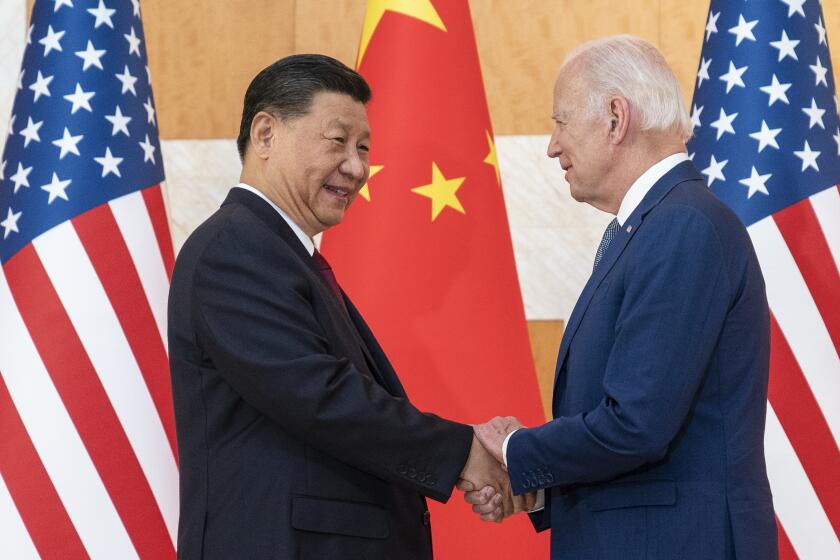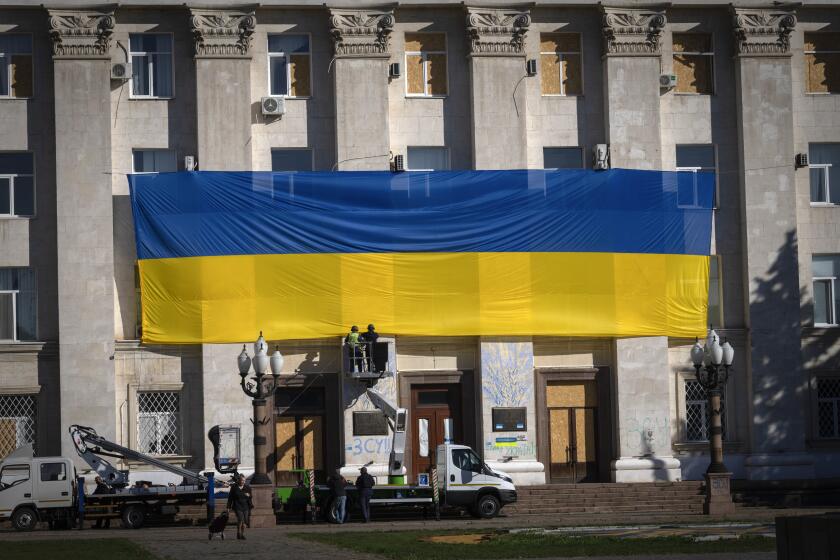Biden and Xi are set to meet next week at the APEC summit. No detail is too small to sweat

- Share via
WASHINGTON — When President Biden meets Chinese leader Xi Jinping on Wednesday, there will be no such thing as a small detail.
How they greet? If they eat? Where they sit? Will there be flowers? Bottled water or in a glass? “Pretty intense,” senior administration officials say of navigating delicate protocols.
Any encounter involving the president and a foreign leader means managing tricky logistics, political and cultural, and every occurrence or utterance can potentially jolt the world order. But few nations are more attuned to etiquette than the Chinese, and the often-conflicting interests between Washington and Beijing might mean the seemingly trivial becomes meaningful.
There’s probably “very detailed planning of the actual choreography of who enters a room where, if there will be pictures taken and all of that,” said Bonny Lin, senior fellow for Asian security and director of the China Power Project at the Center for Strategic and International Studies.
Biden and Xi will meet while both attend next week’s Asia-Pacific Economic Cooperation summit in San Francisco. So far, even basic information has remained closely guarded. Statements Friday by China’s government didn’t mention the day or location. The White House, citing security concerns, says only that the meeting will be held “in the Bay area.”
President Biden and Chinese President Xi Jinping will hold a long-anticipated meeting Wednesday in the San Francisco Bay area.
That could only increase the pressure as both sides potentially haggle over everything from meeting time and length to who enters the room first. Will they use a table or easy chairs? What about security presence and interpreter access?
Then there is the more obviously substantive: Will there be a joint statement after the meeting, and how much of the session will be in public view?
One year since Ukraine retook the city of Kherson from occupying Russian forces, residents have grown accustomed to the sounds of the bombs reminding them that the war is far from over.
The plan is to set aside enough time for in-depth conversations on issues that will be divided into different sessions, senior administration officials say. That recalls Biden’s nearly three-hour meeting with Xi before the start of last year’s G-20 summit in Bali.
The officials also noted that this will be Xi’s first trip to the U.S. in six years, and his first to San Francisco since he was a provincial Communist Party secretary.
Victor Cha, former director for Asian Affairs on the White House’s National Security Council, said organizing such meetings at APEC is easier than at a formal location. But, he said, hammering out talks on summit sidelines is still “a logistics nightmare.”
“China, normally, if they come to United States, they want everything. They want all the pomp and circumstance. They want the highest possible respect that can be paid to them,” Cha said. “That is politically not possible. And so, having APEC in San Francisco solves that problem in the sense that it’s not the official White House that’s hosting the meeting.”
Even informal settings can bring high stakes.
When President Nixon visited China in 1972, aiming to ease decades of animosity, he brought a new pair of shoes with rubber soles to climb the Great Wall.
President Obama and Xi didn’t wear ties during their 2013 meeting at Sunnylands, a modernist mansion in Rancho Mirage near Palm Springs. It was news then that Obama stayed overnight there while the Chinese delegation returned to a nearby hotel.
President Trump and Xi wore dark suits for dinner at Trump’s Mar-a-Lago estate in Florida four years later. The meal featured what Trump called “the most beautiful piece of chocolate cake.”
Bonnie Glaser, managing director of the Indo-Pacific program at the German Marshall Fund, said that, for the upcoming meeting, Xi’s team likely pushed for a venue away from the APEC site and talks lasting longer than those in Bali.
“The Chinese want a separate summit,” she said.
The Chinese attach importance to the location, which this time may be more like Sunnylands than Anchorage, where top U.S. and Chinese officials held rather tense 2021 talks.
Chinese state media might fixate on the weather as a barometer for bilateral relations. Early forecasts are calling for rain with a high in the mid-60s for San Francisco.
Even the bouquets could matter, as certain choices symbolize harmony in Chinese culture. Plum blossom is known in China for persevering amid harshness, while lotuses convey peace. Chrysanthemums, in contrast, are associated with death.
Xi may expect Biden to greet him upon arrival. Xi’s team could also want the leaders photographed together without staff to convey a personal relationship.
“Chinese officials will want to project to their domestic audience that Xi is received by Biden with dignity and respect,” said Ryan Hass, director of the John L. Thornton China Center at the Brookings Institute. He suggested that required “imagery of both leaders interacting on a personal basis, beyond the customary handshake in front of a bank of flags in a hotel conference room.”
That could be as simple as a short walk together, Hass said. The Chinese also tend to emphasize food and might push for a meal.
During Nixon’s 1971 visit, a military honor guard greeted him at the airport, but the much-watched series of toasts from both sides came later, only after a shark fin banquet dish was served. China offered a Texas-style barbecue at a luxury Beijing hotel to fete President George H.W. Bush in 1989, but blocked his invitation of Fang Lizhi, then the country’s best-known dissident.
The APEC setting precludes a formal dinner. But lunch is possible. That’s despite Xi scheduling his trips down to the minute and often packing in so much that there’s no time to eat, according to a documentary on its diplomatic principles China released in 2017.
Both sides also always have security concerns. Obama wrote in his memoir of his 2009 China trip that his team was “instructed to leave any non-governmental electronic devices on the plane” and to operate assuming “that our communications were being monitored” and hotel rooms had hidden cameras.
Hillary Clinton, visiting Beijing in 1995 as first lady, turned heads when she declared that “human rights are women’s rights, and women’s rights are human rights.” So did then-First Lady Laura Bush’s 2008 trip to the Olympics in Beijing after she stopped in Thailand and visited a refugee camp for people fleeing the China-backed government of Myanmar.
But protocols around U.S.-China leader interactions don’t always have to address espionage threats or human rights matters.
Obama’s daughter Sasha was 9 and studying Mandarin in school when she practiced a few phrases during a 2011 White House welcome ceremony for Chinese President Hu Jintao. When she and her sister Malia visited China with their mother, Michelle, on a goodwill tour three years later, the Chinese press dubbed the then-first lady “Mrs. Diplomatic.”
That trip featured a toboggan ride away from the press after a Great Wall visit, and a game of table tennis where Michelle Obama joked that her husband plays and “thinks he’s better than he really is.” Yet what unfolded felt stiff to some. The write-up in the New York Times carried the headline: “Even With Ping-Pong, a Formal Meeting in China.”
More to Read
Sign up for Essential California
The most important California stories and recommendations in your inbox every morning.
You may occasionally receive promotional content from the Los Angeles Times.















